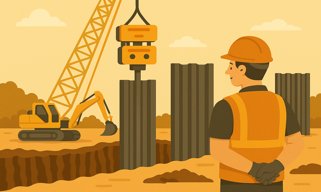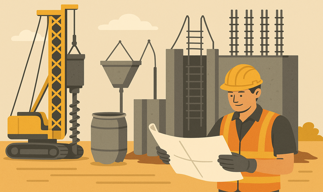How Diaphragm Wall Technology is Transforming Basement Construction in Ahmedabad
Ahmedabad’s on a roll. Skyscrapers are shooting up, metro lines are burrowing down, and the city’s buzzing with new projects. But with great growth comes great challenges, especially when you’re digging deep in a city with tricky soil and tight spaces. That’s where diaphragm wall technology comes in, shaking up how we build basements. It’s not just a fancy engineering trick—it’s a practical, rock-solid solution that’s making deep excavations safer, faster, and smarter. Let’s break down how this method is changing the game for basement construction in Ahmedabad.
Why Ahmedabad’s Going Deep
The city’s skyline is getting a serious makeover. From sleek residential towers to sprawling commercial hubs, Ahmedabad’s building boom demands deep basements for parking, utilities, or retail spaces. Old-school techniques like piling or open excavations often struggle in urban areas where the ground’s unstable or the water table’s high. Diaphragm walls, or D-walls, step up with reinforced concrete barriers that keep soil and water at bay while supporting massive structures. Diaphragm wall for deep basements in Ahmedabad is becoming a must-have, letting developers maximize space without risking collapse or delays.
What’s a Diaphragm Wall, Anyway?
Imagine digging a narrow trench, maybe a meter wide, deep into the earth. To stop it from caving in, you fill it with a slurry mix—think bentonite or polymer. Then, you drop in steel cages and pour concrete to create a sturdy, seamless wall. These walls don’t just hold back the earth during digging; they often become the basement’s permanent walls, saving time and cash. In a city like Ahmedabad, where every square foot is gold, diaphragm wall for deep basements in Ahmedabad tackles tight spaces and tough conditions with ease.
Tackling Ahmedabad’s Unique Challenges
Ahmedabad’s got a mixed bag of soil—sandy in some spots, clayey in others, with rocky patches to spice things up. Add in high groundwater levels near the Sabarmati River, and you’ve got a recipe for construction headaches. Traditional piling means pumping out water and building extra supports, which burns money and harms the environment. Diaphragm walls act like a waterproof shield, keeping water out and soil stable. Projects like the Sabarmati Riverfront redevelopment show how this tech shines. Diaphragm wall for deep basements in Ahmedabad makes it possible to build strong foundations without drowning in problems.
The Big Wins of Diaphragm Walls
Built Like a Fortress
These walls are tough. They can handle the weight of high-rises while keeping nearby buildings safe from settling or cracking. In Ahmedabad’s crowded neighborhoods, that’s a lifesaver. Projects like Venus Stratum and Binori BSquare have used this tech to carve out multi-level basements that would’ve been impossible otherwise. Diaphragm wall for deep basements in Ahmedabad delivers the strength to dream big without worrying about the ground giving way.
Keeping Water at Bay
Water’s a constant issue in Ahmedabad, especially near the river. Diaphragm walls are practically watertight, thanks to sealed joints and waterstops. No need for endless pumping to keep basements dry, which saves time and money. Metro stations across the city have leaned on this tech to stay flood-free during construction. Diaphragm wall for deep basements in Ahmedabad ensures buildings stay dry and secure, even in soggy conditions.
Quiet and Neighbor-Friendly
Piling can sound like a demolition derby, rattling nearby homes and offices. Diaphragm wall construction is way quieter, using hydraulic rigs like Casagrande’s to dig with minimal noise and vibration. In Ahmedabad’s packed urban areas, this is a huge plus. Diaphragm wall for deep basements in Ahmedabad keeps the peace while getting the job done, making it a favorite for developers who want to avoid complaints.
Works in Any Soil
From sandy to clayey to rocky, Ahmedabad’s soil is all over the place. Diaphragm walls don’t care—they can go deep, up to 80 meters, in almost any condition. This makes them perfect for everything from residential towers to metro tunnels. The Ahmedabad Metro’s underground stations rely on this flexibility. Diaphragm wall for deep basements in Ahmedabad adapts to whatever the ground throws at it, giving engineers freedom to design without limits.
Green and Cost-Smart
Sustainability isn’t just a buzzword here. Diaphragm walls cut down on excavation waste and use materials efficiently, reducing the environmental hit. They also double as permanent walls, saving on extra supports. Grimtech, a local outfit, has been using this tech to deliver eco-friendly projects that don’t break the bank. Diaphragm wall for deep basements in Ahmedabad aligns with the city’s push for greener growth, proving you can build big and still keep it sustainable.
Real-Life Success Stories
Ahmedabad’s full of projects showing off diaphragm walls. The Ahmedabad Metro uses them for its underground stations, handling tricky soil like a pro. Residential and commercial spots like The Corner Block and Z2 have multi-level basements for parking and retail, all thanks to D-walls. These projects prove the tech’s worth in tackling site-specific challenges. Diaphragm wall for deep basements in Ahmedabad is turning ambitious plans into reality, one solid wall at a time.
Overcoming the Humps
Nothing’s perfect, and diaphragm walls have their challenges. Digging in unstable soil or managing slurry waste can get messy. But with proper soil studies and on-site slurry treatment, these issues are manageable. Real-time monitoring and self-compacting concrete keep quality high. Diaphragm wall for deep basements in Ahmedabad overcomes these hurdles with expertise and top-notch gear, ensuring projects stay on track.
The Power of Modern Machines
The tech’s success leans heavily on advanced equipment. Casagrande rigs, used in over 250 Ahmedabad projects in the last two years, dig with precision and handle depths up to 80 meters. They keep walls straight and strong, even in tough conditions. Diaphragm wall for deep basements in Ahmedabad relies on these machines to meet the city’s growing need for robust foundations.
Looking Ahead: A Sustainable Future
Diaphragm walls are paving the way for greener construction. By cutting waste and disruption, they fit Ahmedabad’s vision for sustainable urban growth. As the city plans taller buildings and more metro lines, this tech will be key. Techniques like vibro stone columns can boost soil strength, making projects even more efficient. Diaphragm wall for deep basements in Ahmedabad is set to shape the city’s future, supporting resilient, eco-friendly infrastructure.
The Bottom Line
Diaphragm walls are more than a construction technique—they’re a revolution for Ahmedabad’s building scene. With their strength, water-tightness, and flexibility, they’re tackling the city’s toughest challenges head-on. As Ahmedabad grows into a global metropolis, diaphragm wall for deep basements in Ahmedabad will keep leading the charge, building a foundation for a stronger, smarter, and more sustainable city.
FAQ:
1: Why are diaphragm walls the preferred choice for deep basements in Ahmedabad?
Diaphragm walls are ideal for deep basements in Ahmedabad due to their strength, watertight structure, and adaptability to the city’s diverse soil conditions. Whether it’s sandy layers near the Sabarmati or clay zones in SG Highway areas, diaphragm walls provide reliable, long-lasting basement support even under high water tables.
2: How do diaphragm walls help with groundwater issues in Ahmedabad?
Diaphragm walls act as impermeable barriers, preventing groundwater from seeping into excavation sites. This is crucial in Ahmedabad, especially near the riverfront or low-lying areas where the water table is high. Their sealed joints and waterstops reduce the need for constant dewatering and help maintain dry, stable basements.
3: Are diaphragm walls suitable for Ahmedabad’s mixed soil conditions?
Yes, diaphragm walls are highly adaptable and perform well in Ahmedabad’s varying soil profiles—from sandy to rocky to clayey. They can be built up to 80 meters deep using advanced rigs like Casagrande, making them ideal for metro stations, high-rises, and multi-level commercial basements across the city.
4: What are the benefits of diaphragm walls for urban projects in Ahmedabad?
For tight urban zones like Maninagar or Navrangpura, diaphragm walls offer quiet, low-vibration construction—minimizing disturbance to nearby homes and structures. They also save space by doubling as permanent basement walls, making them a smart solution for space-constrained sites.
5: Are diaphragm walls in Ahmedabad considered eco-friendly or sustainable?
Yes. Diaphragm wall construction generates less excavation waste, reduces dewatering needs, and uses materials efficiently. Since the walls serve as both temporary and permanent support, they reduce the carbon footprint of construction—aligning with Ahmedabad’s shift toward greener, smarter infrastructure.




